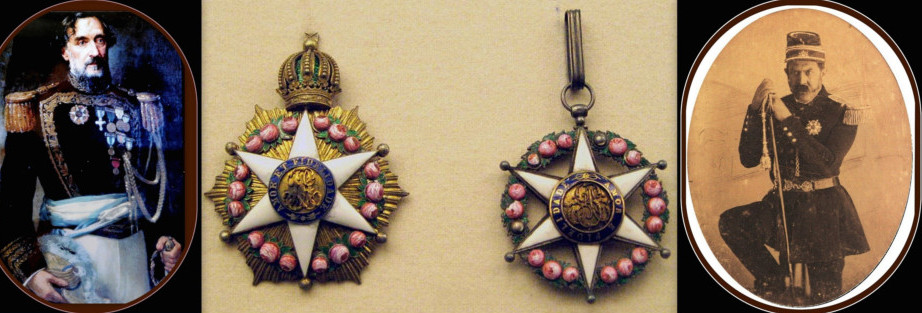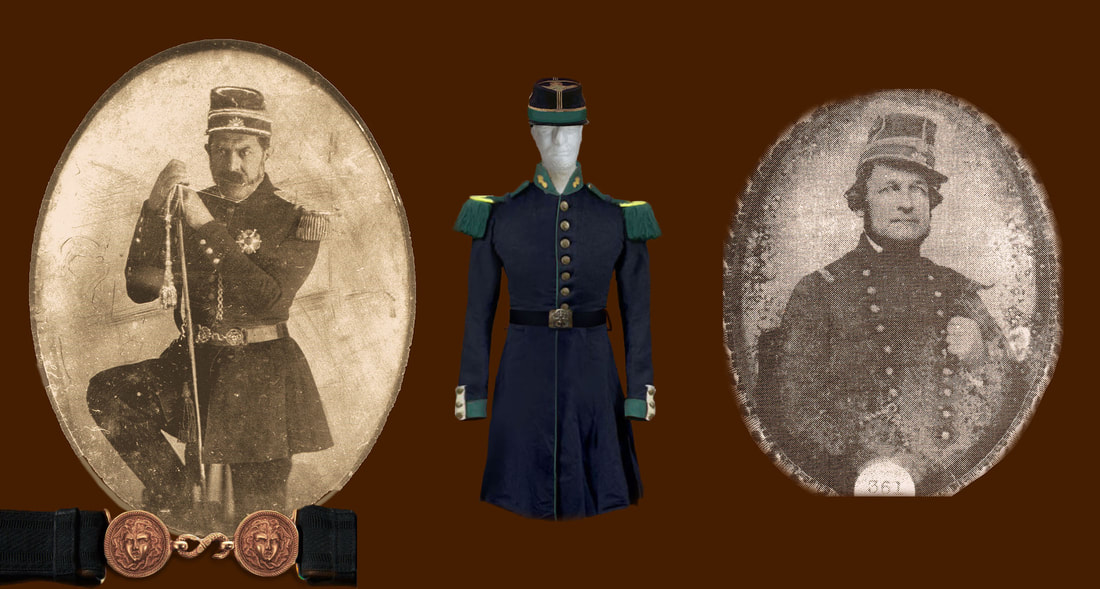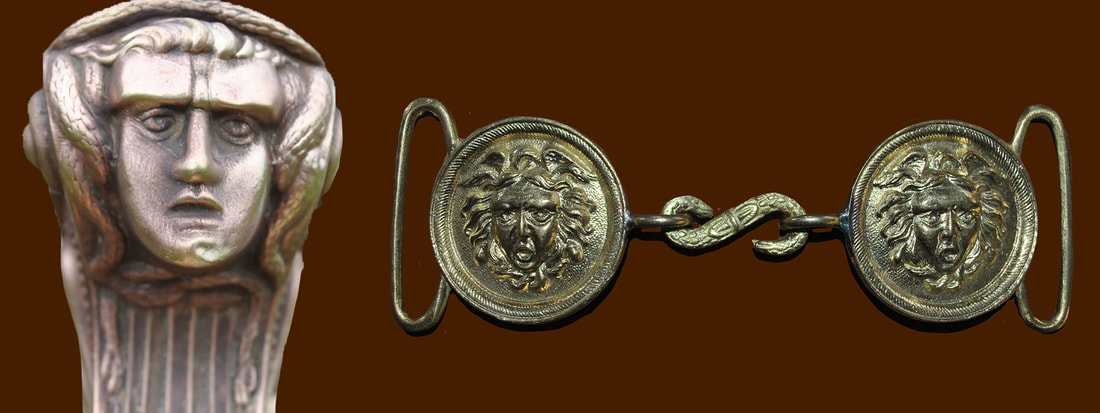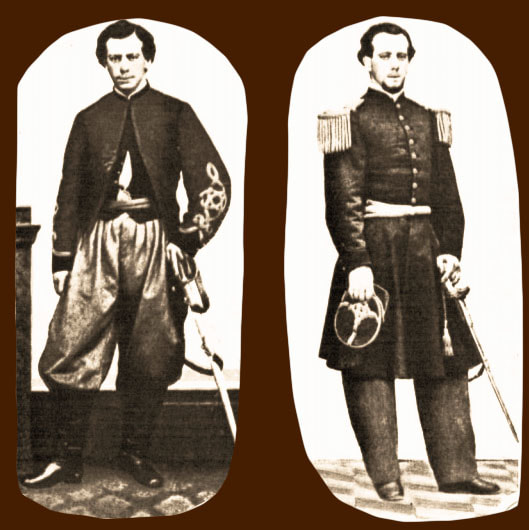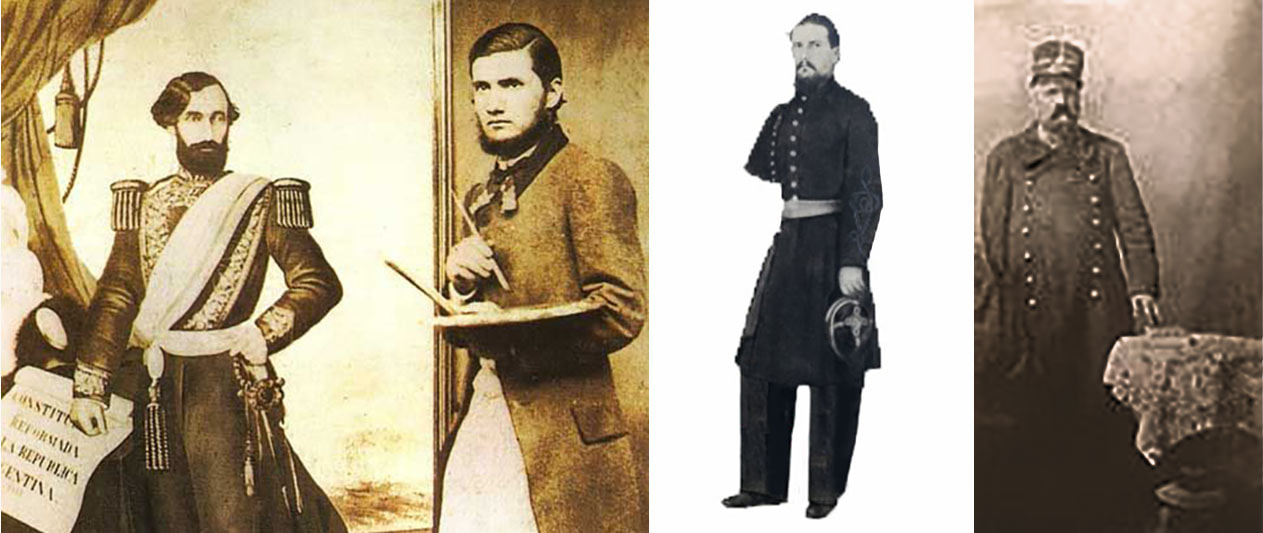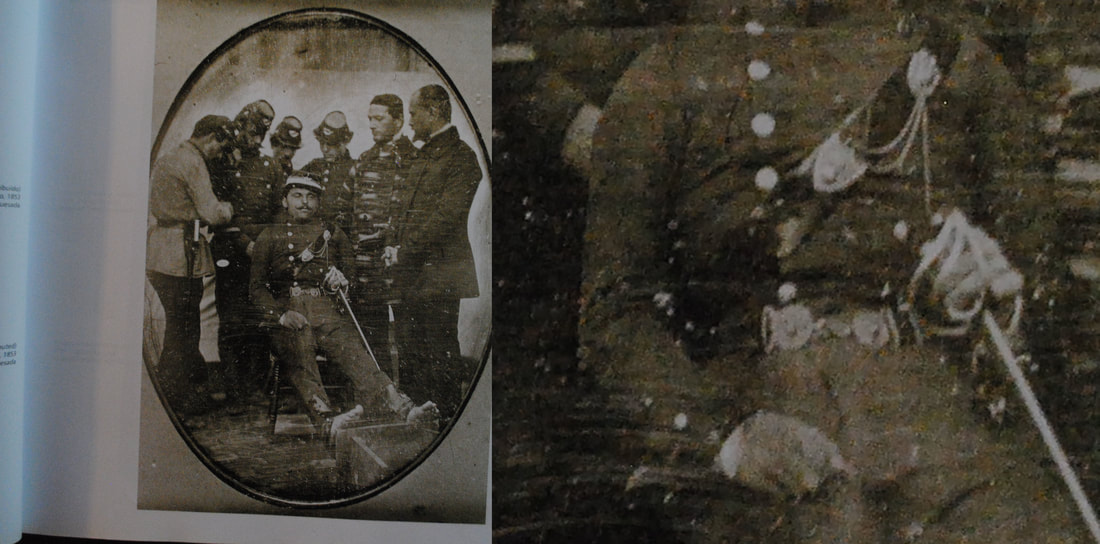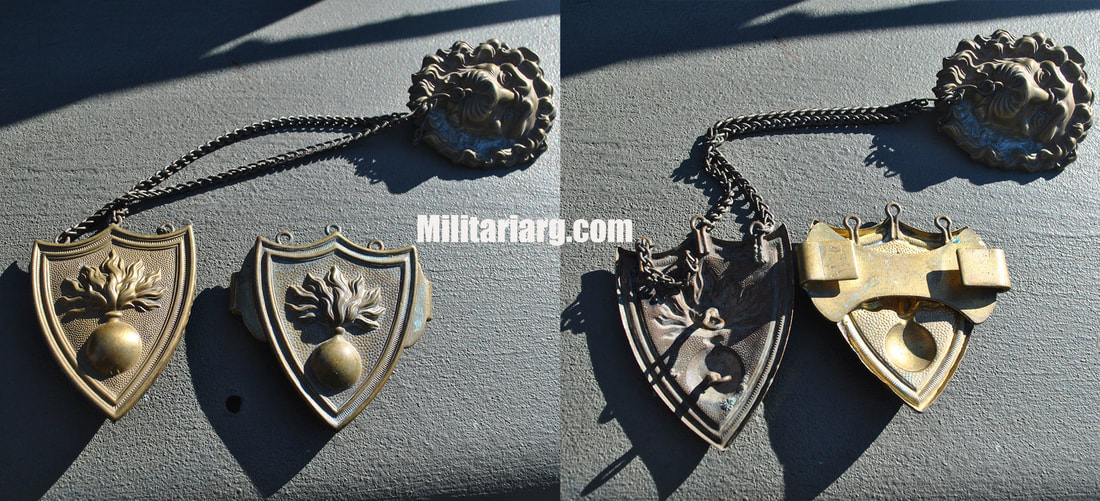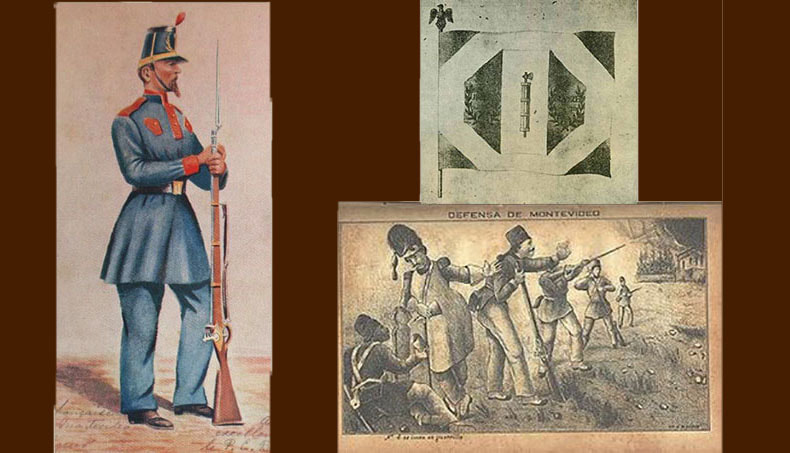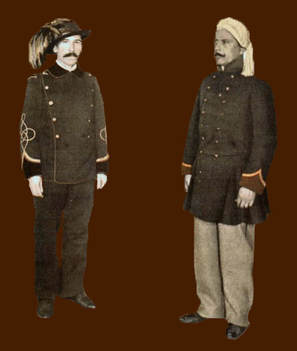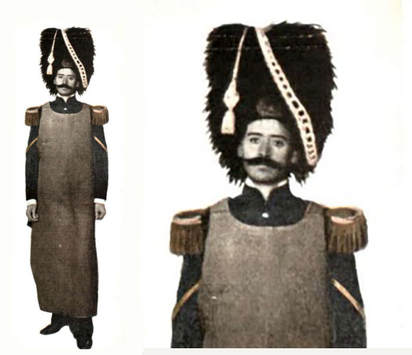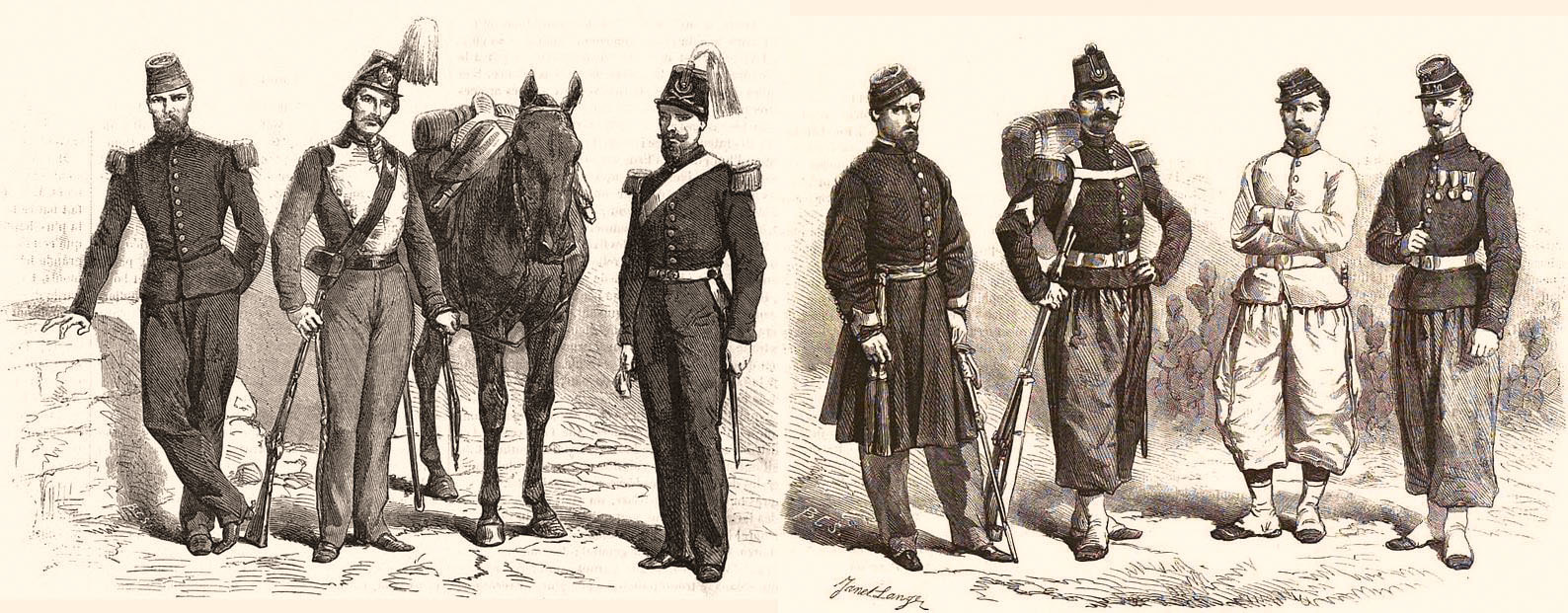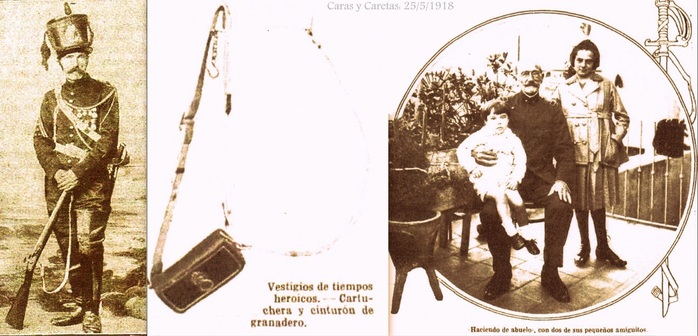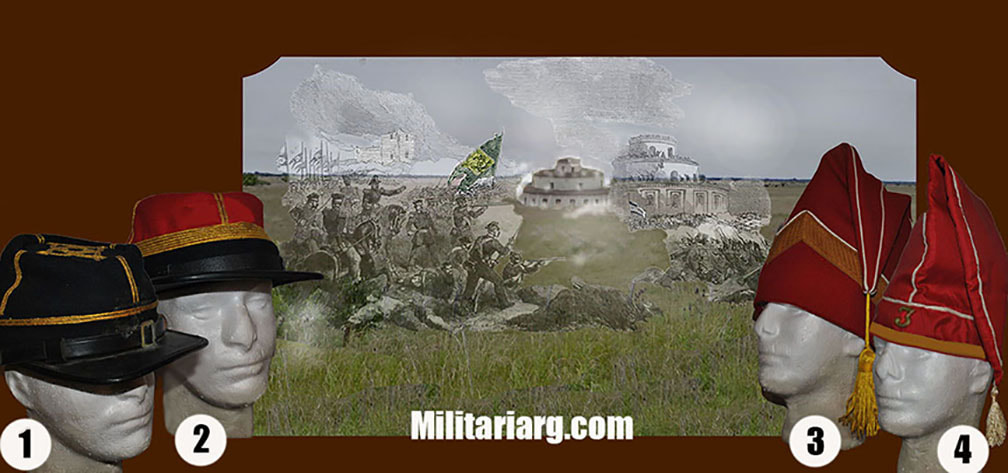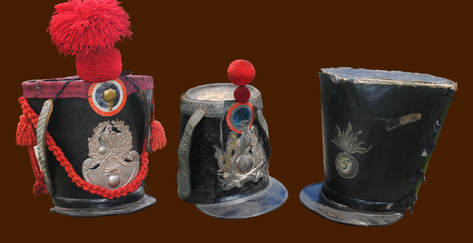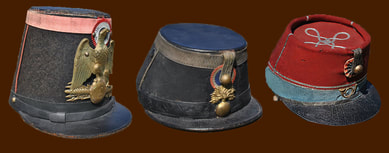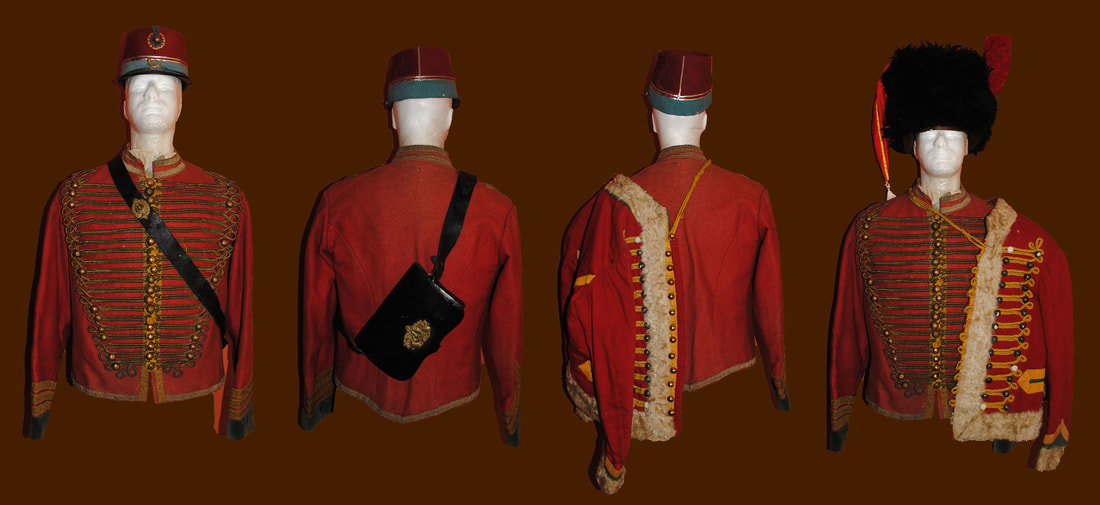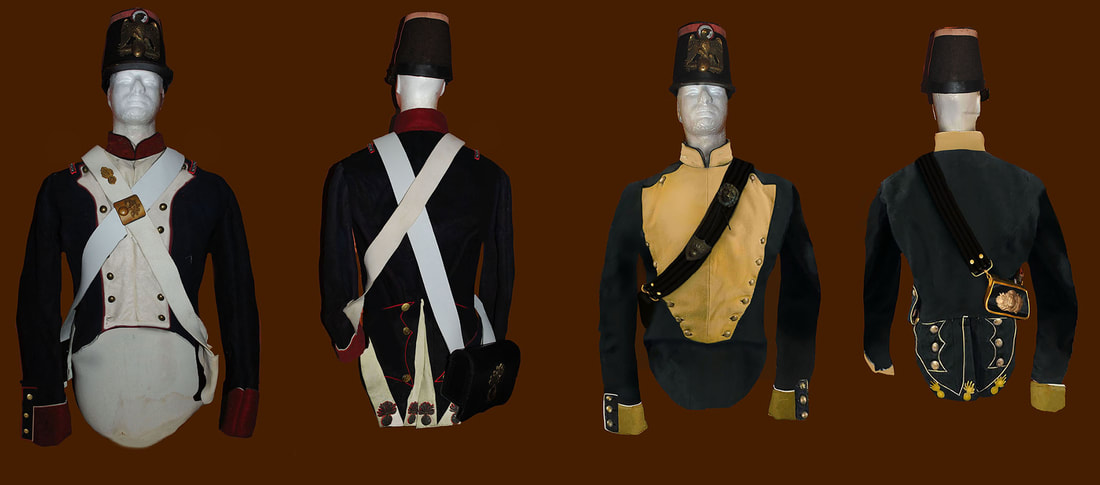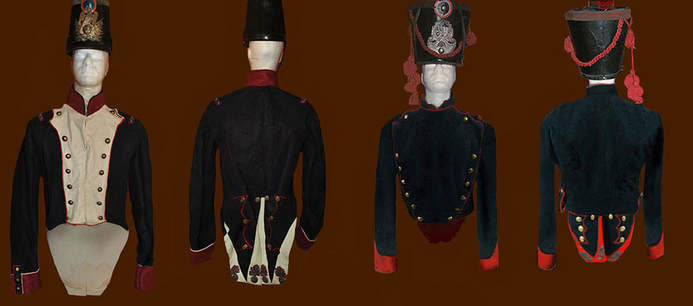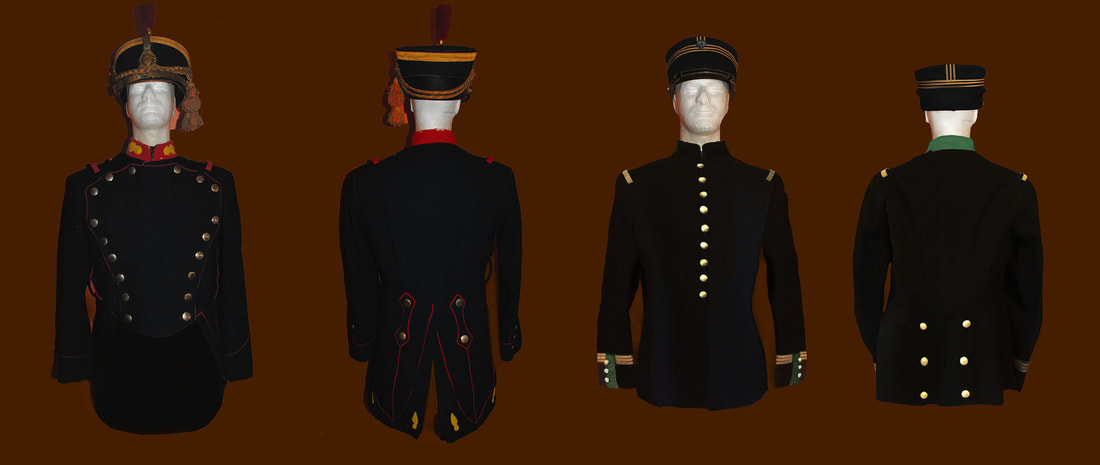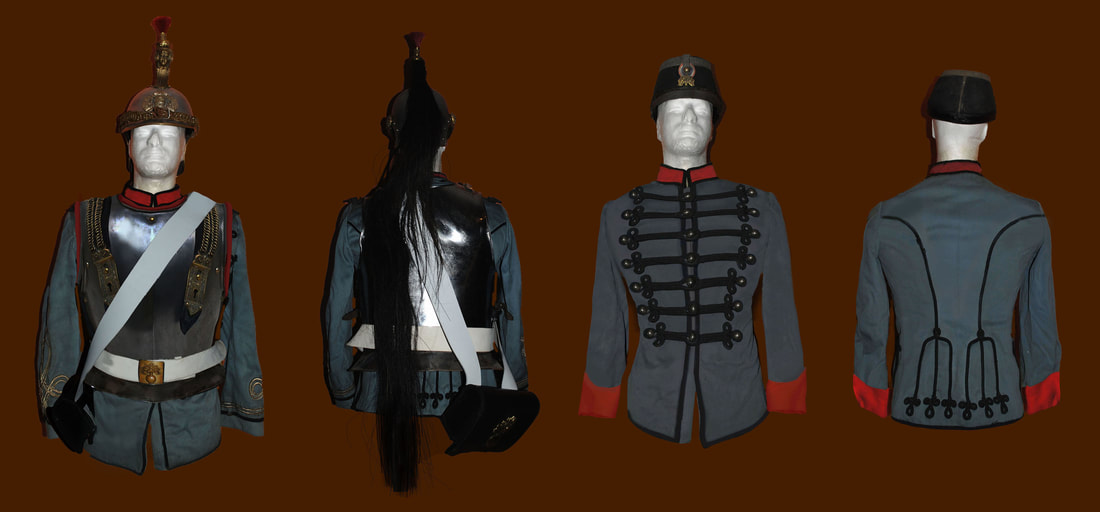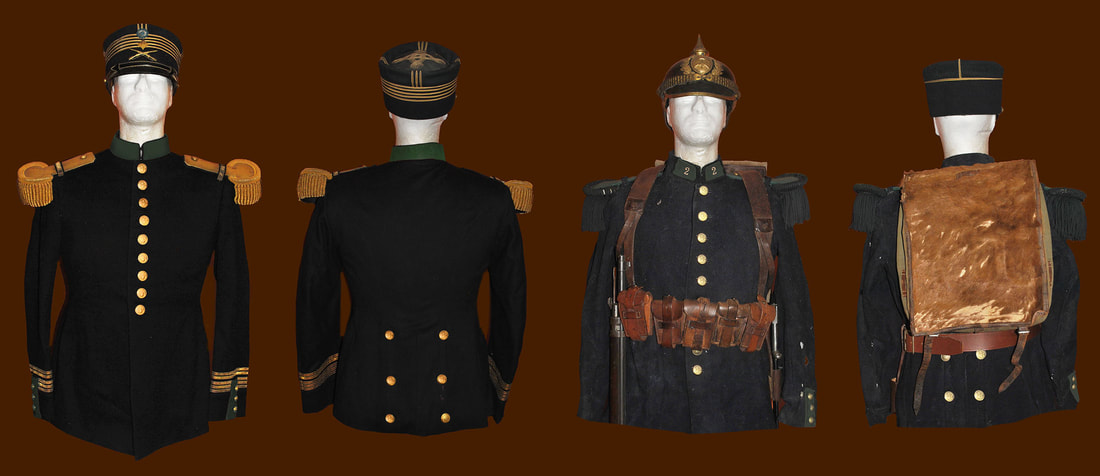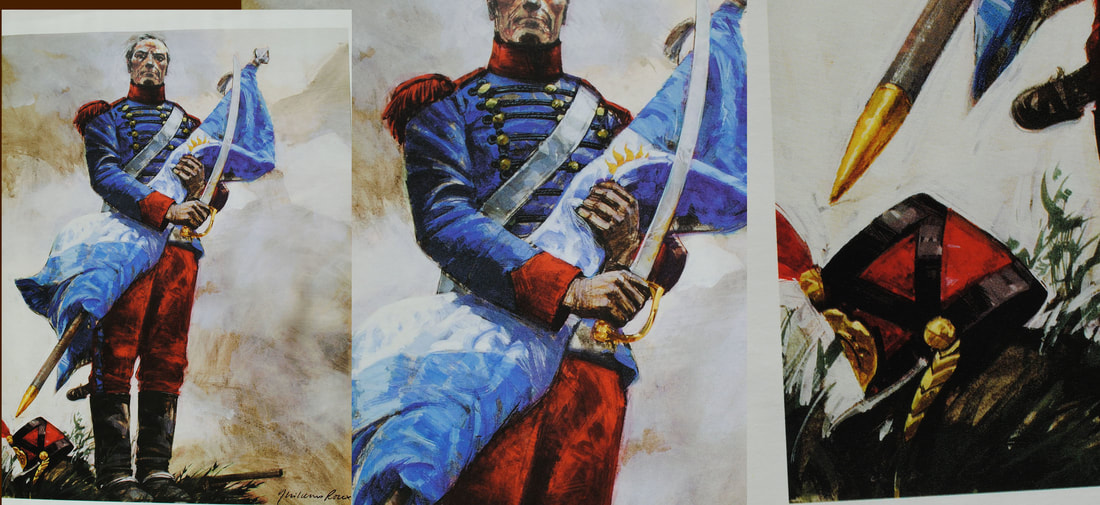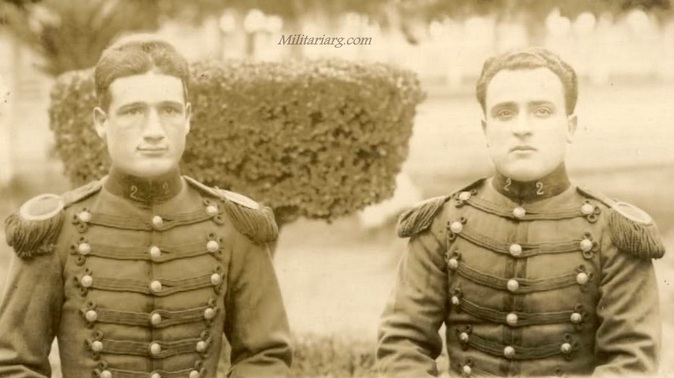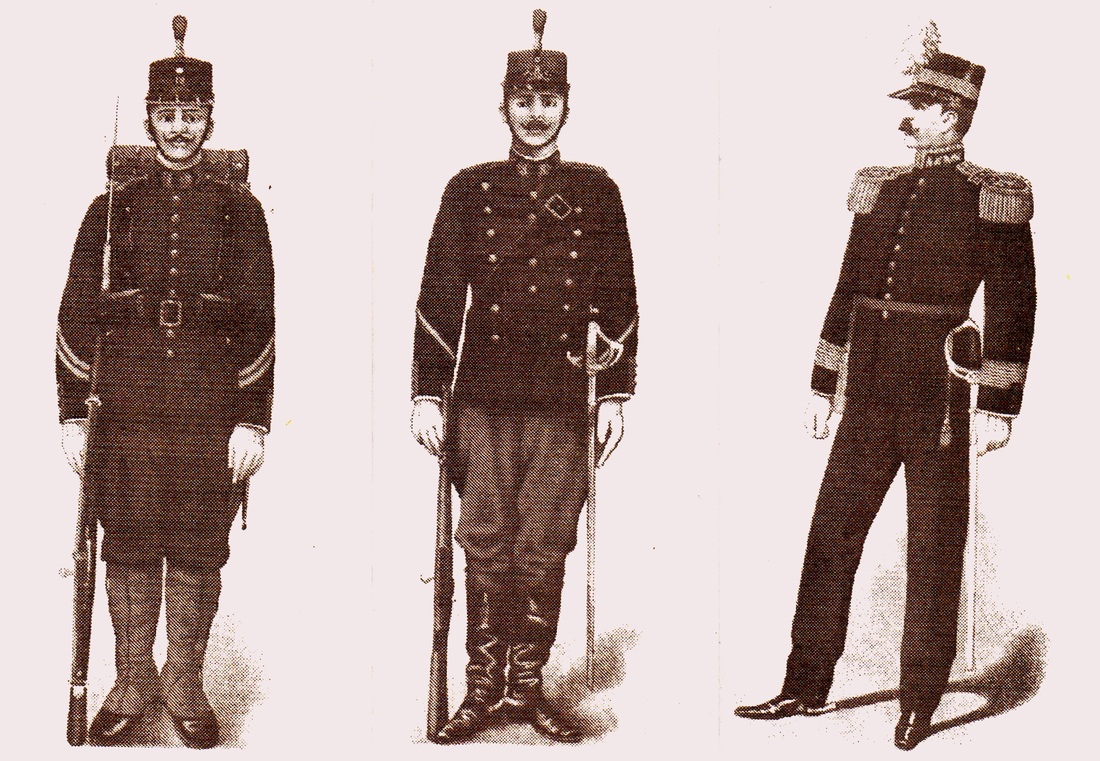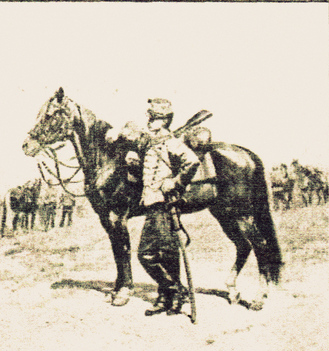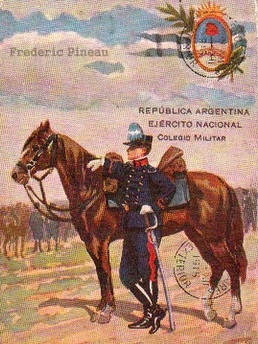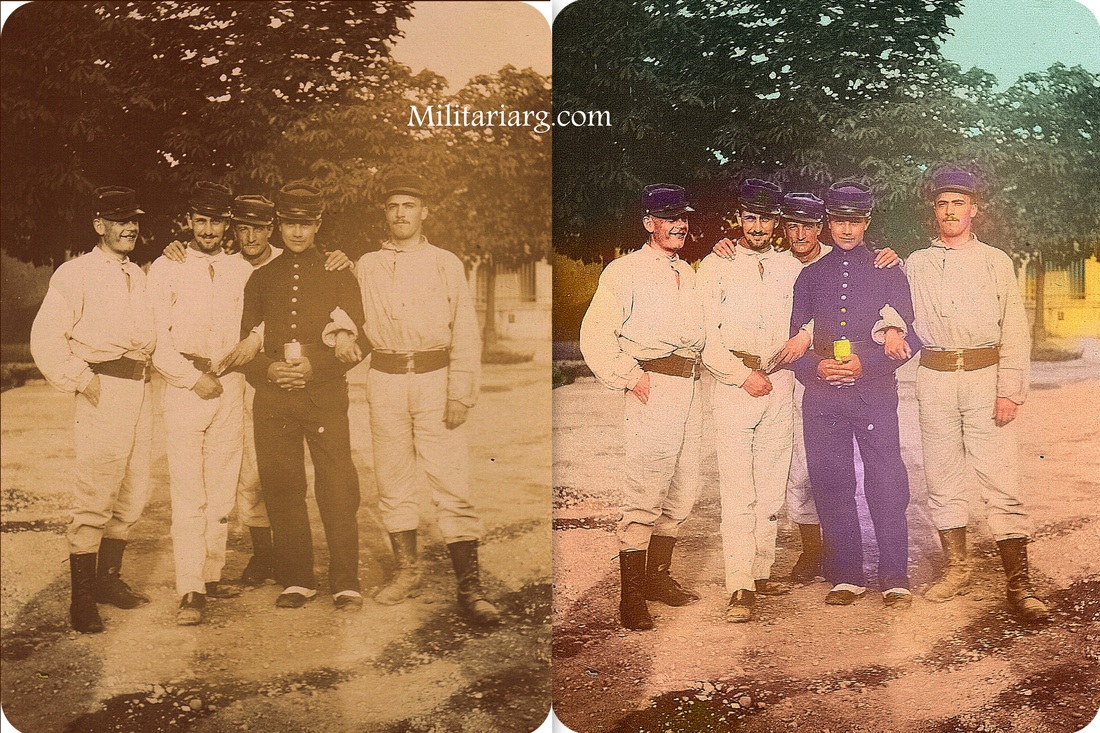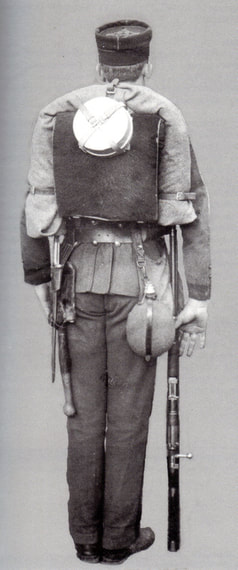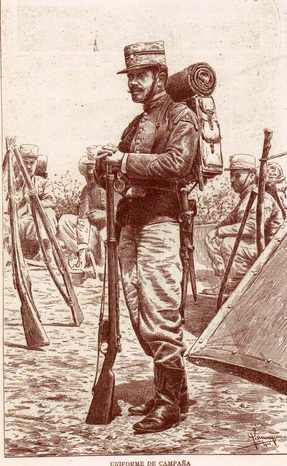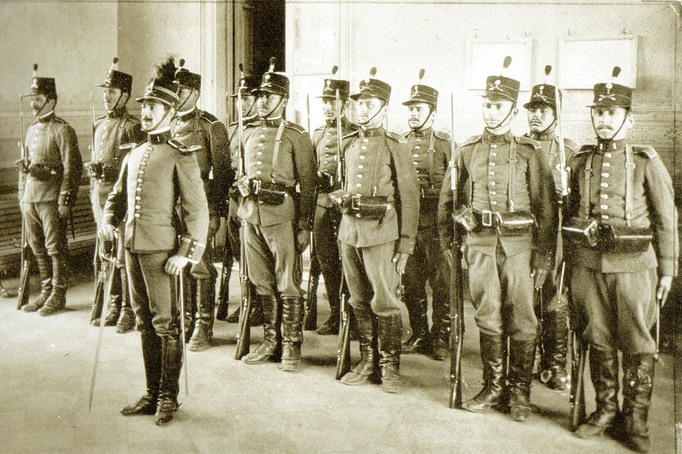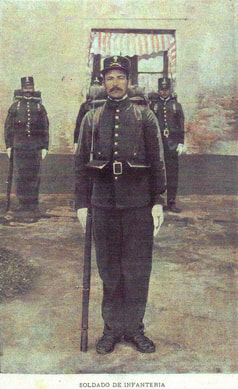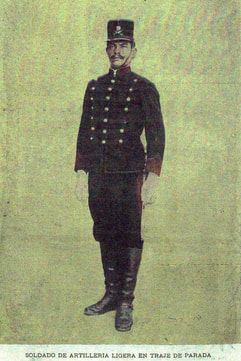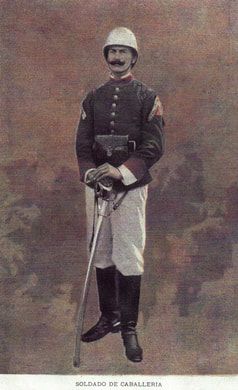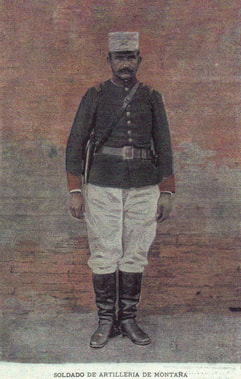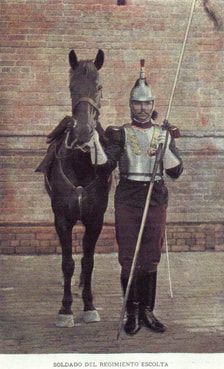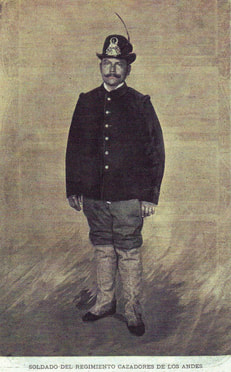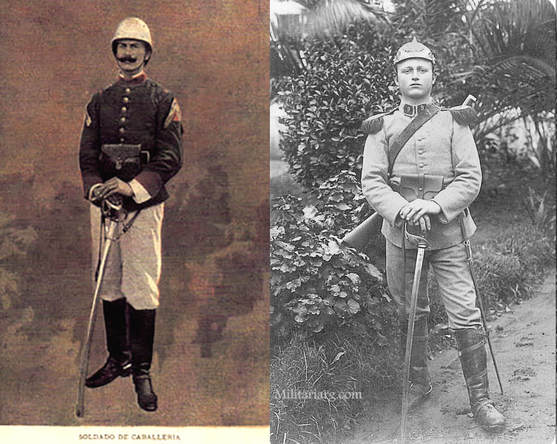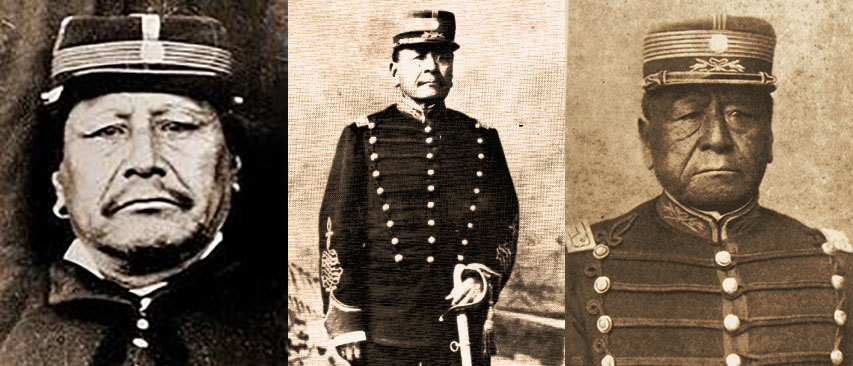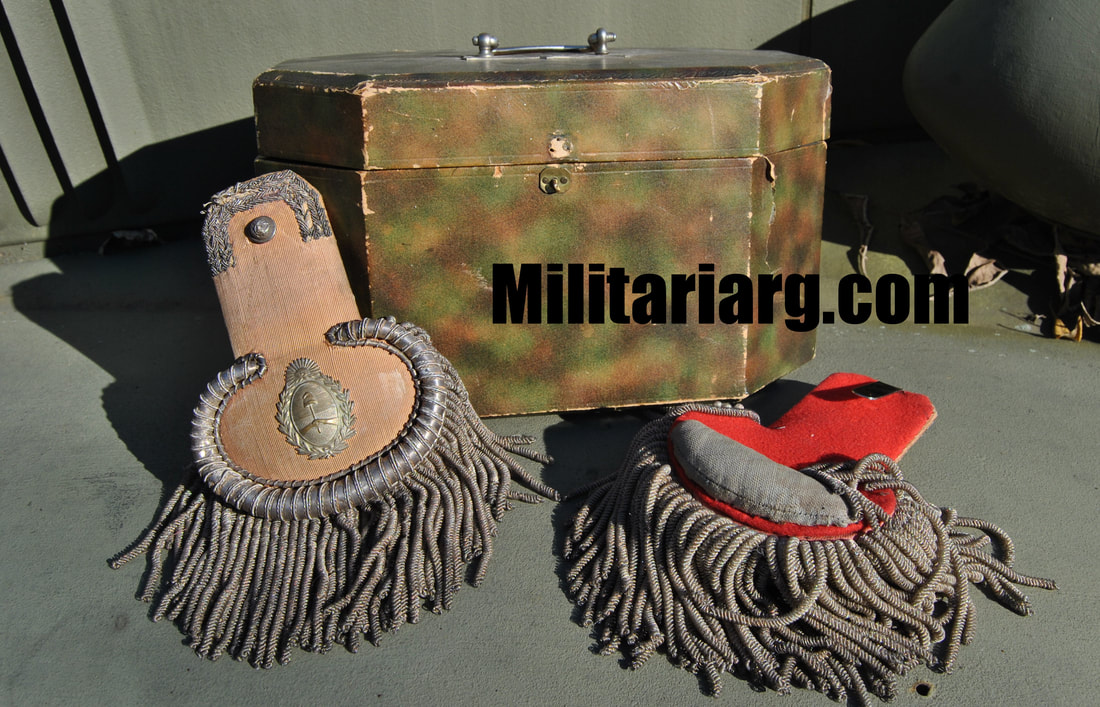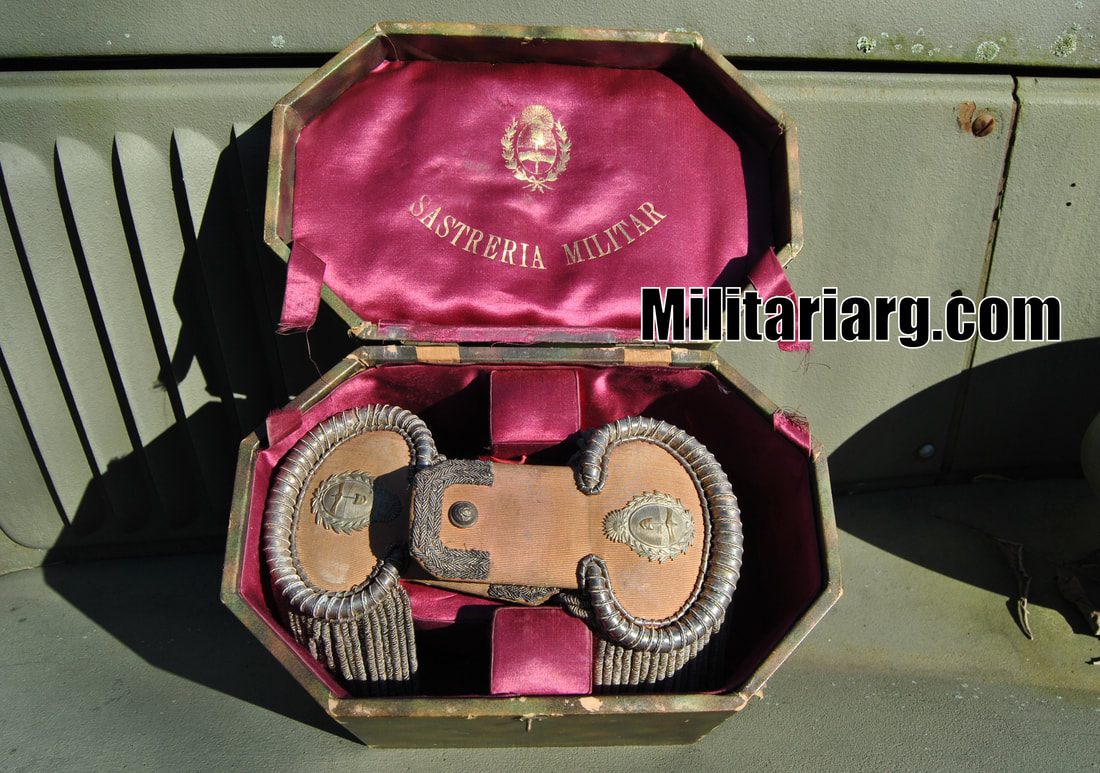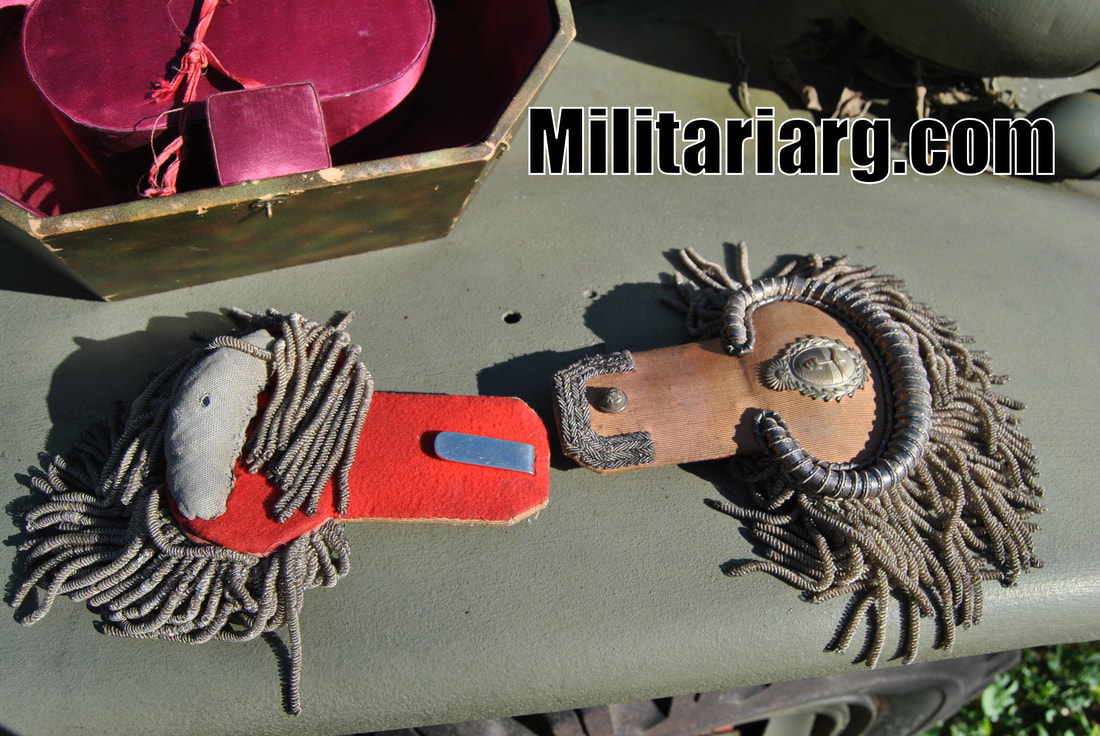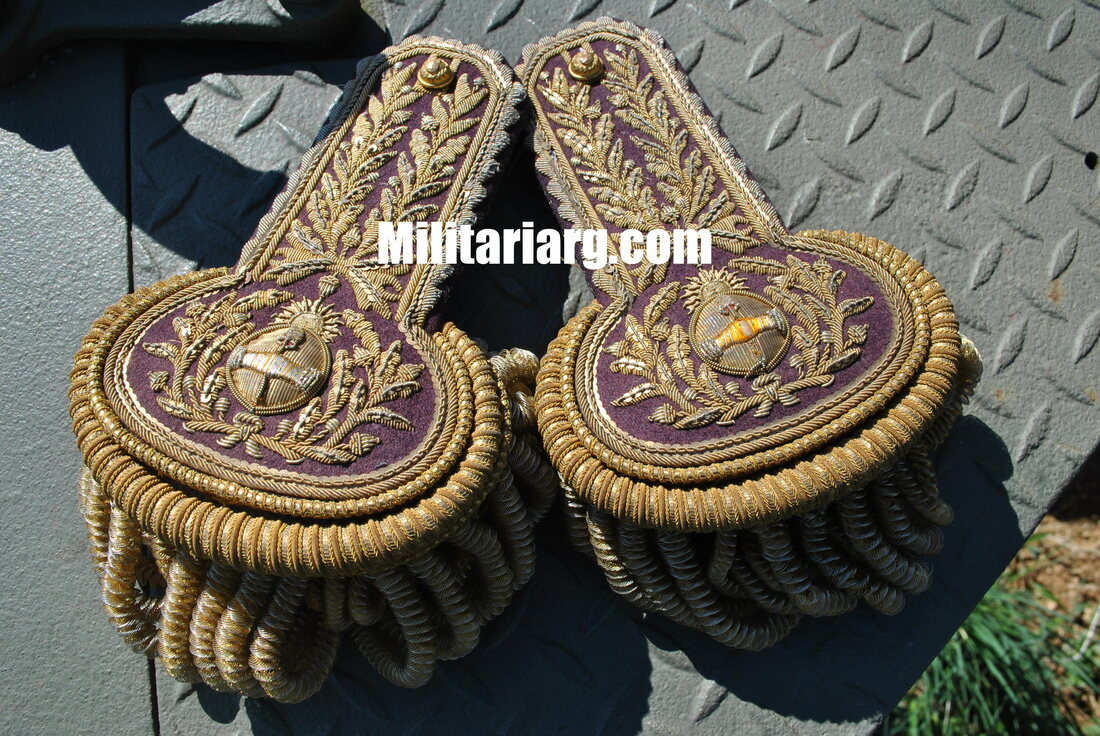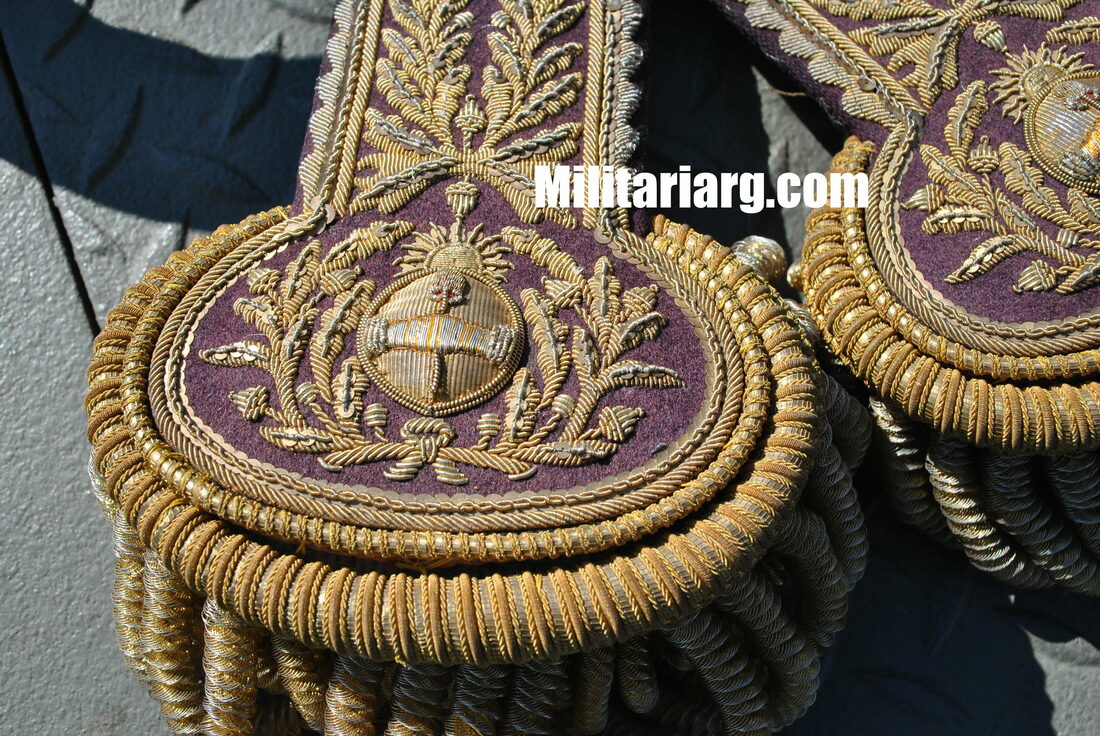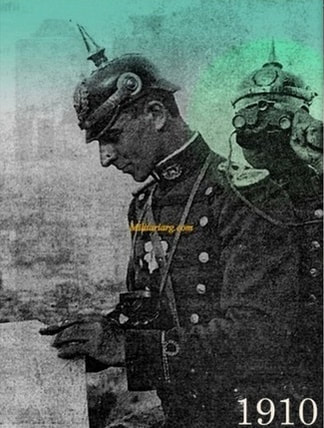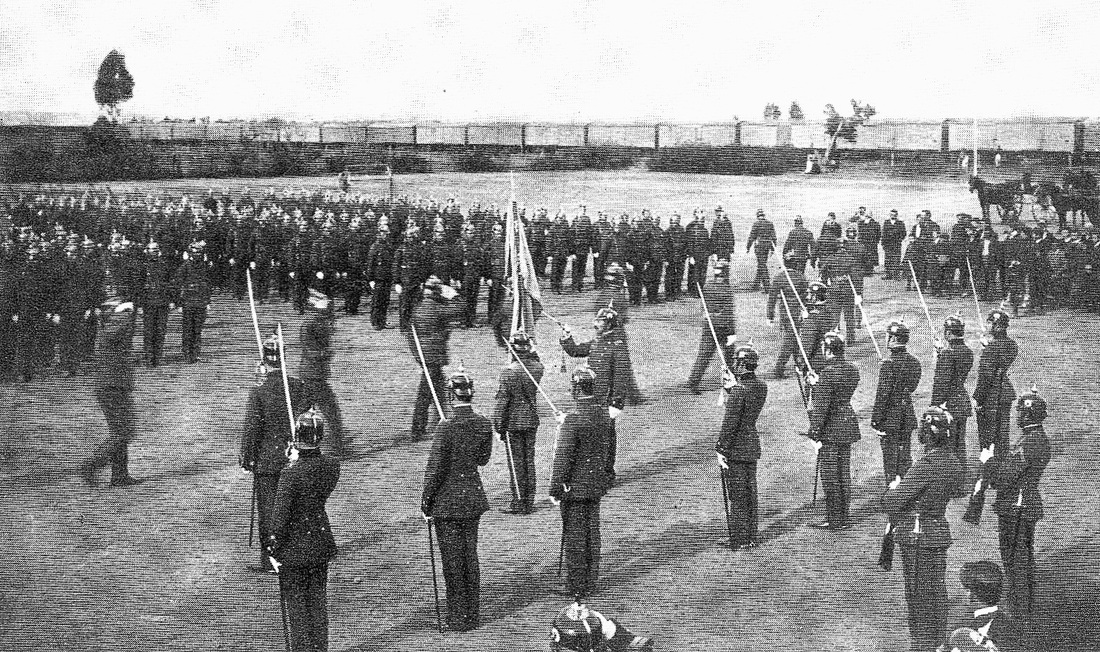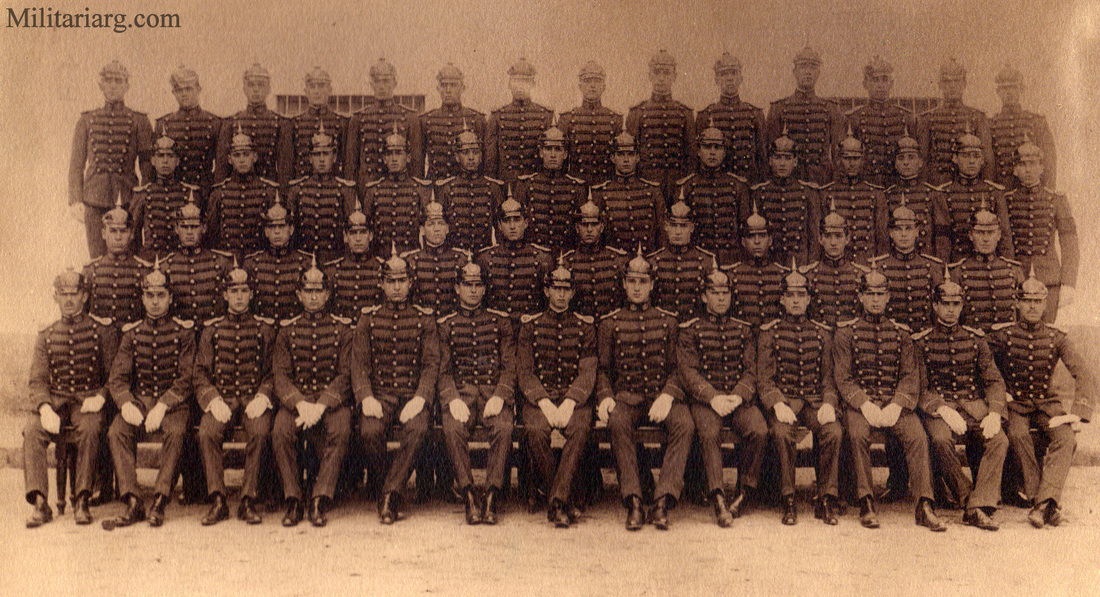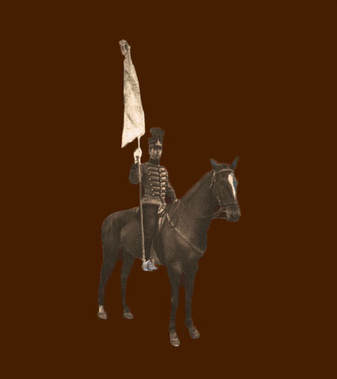Bartolome Mitre and Domingo Faustino Sarmiento, (Unitarian Party) honored with the Order of the Rose by Brazil Emperor Pedro II for their services in Caseros 1852 . The Imperial Order of the Rose (Portuguese: Imperial Ordem da Rosa) is a Brazilian order of chivalry, instituted by Emperor Pedro I of Brazil on 17 October 1829. Wikipedia.
Above middle: Recreation of a typical uniform of the line infantry and also used by the national guards of the separatist "State of Buenos Aires" between 1853 and 1855. The mannequin wears a French tunic model 1845 and an early kepi colonial model from 1850. According to several portraits of the time you see the same type of clothes. To the right and left are portraits of Sarmiento and Pedernera, made shortly after the Battle of Caseros in 1852. These photos show very new French uniforms for that time, taking into account that colonial kepi began to be used in Africa around 1850, replacing the shako in warm climates. The green shoulder pads (epaulettes) are the same as the French foot hunters (Chasseur a pied).
Sarmiento's cloth belt buckle is from the French model of cavalry used since the time of the First Empire, but it has the head of Medusa as worn by the French superior officers since the Second Empire.
Sarmiento's cloth belt buckle is from the French model of cavalry used since the time of the First Empire, but it has the head of Medusa as worn by the French superior officers since the Second Empire.
Left: Medusa head in the French cuirassier or dragoon helmet model 1871 -72. Right Medusa French cavalry buckle. The face or head of Medusa appears for some reason in various French military ornaments and decorative touches, from bandoliers to swords. In the case of the cuirassier helmet crest model 1872 that arrived in Argentina in the last decade of the 19th century, the crest of Medusa was reproduced in the successive models made in Argentina during the 20th century.
Left: Medusa head in the French cuirassier or dragoon helmet model 1871 -72. Right Medusa French cavalry buckle. The face or head of Medusa appears for some reason in various French military ornaments and decorative touches, from bandoliers to swords. In the case of the cuirassier helmet crest model 1872 that arrived in Argentina in the last decade of the 19th century, the crest of Medusa was reproduced in the successive models made in Argentina during the 20th century.
Two stages in the military career of ex-President Julio Roca. Left: In a French Zouave uniform, with the rank of infantry Lieutenant in 1865. Right: In 1866 with the rank of Sergeant Major (Former officer grade) with French jacket type 1845. The campaign uniform would be that of the left and parade is the one on the right.
Several stages of the artist Candido Lopez. His youth, when he immortalized Mitre in painting. His return from the sad War against Paraguay (War of the Triple Alliance), without his arm. And his last years.
French ornaments for cavalry bandolier, lion head, and grenade. This type of decoration in the bandoliers was of French origin, used since the Napoleonic wars or before. In Argentina it was widely used in allied armies or supported by France. Below, a photo of the book "Soldados 1848 - 1927" page 32' In the photo, the wake of Lieutenant Feloni or Felloni, of the Italian Legion fallen after a battle with federal forces that besieged Buenos Aires in order to take it back after the defeat of 1852. These ornaments were used in gala uniforms.
1843 French Legion during the Uruguayan Independence War. Defending Montevideo there were several foreign legions, such as the French, Italian, Spanish, and Swiss among others. This last one after 1852 would settle in the outskirts of Buenos Aires like Legion Agricola Militar. In the French uniforms there are several models that will later be imposed on the Argentine Army, in the case of the shako model 1837 worn by the French legionary.
Circa 1850 - Italian Legion (Bersaglieri Style) and Spanish Legionary (Carlista Style) Interesting 1928 recreations published in the magazine "Caras y Caretas"
The photo recreates a Sapeur from the armies of Argentina during the 19th century. "Caras y Caretas" 1928.
The illustrated presidential escort (second from the left), wears a French model 1858 jacket and probably a 1858 French bandolier, the 1845 shako, and a cavalry flintlock carbine.
Seargeant Dubroca,. Veteran of Caseros Battle. Ex-Argentine Confederation (Rosas Soldier), "Abastecedores de Corrales" Juan de Dios Videla Division 1852. In 1854 he was in service as grenadier of the Escort Regiment or Presidential Guard. Between 1852 and 1897 he participated in numerous campaigns and revolutions. In 1897 he formed the guard of the mausoleum of San Martin in the cathedral of Buenos Aires.
In 1880 the remains of General San Martin were repatriated from France. To guard his remains that have since rested in the -Metropolitan Cathedral, a Grenadier guard was re-created. Taking into account all the campaigns in which Sergeant Dubroca participated, it is probable that this unit of honor has been integrated by veterans of military campaigns. To recreate the historical uniform, this type of French cavalry jacket model 1858 (like the one in the photo) was probably used, along with the old French shako model 1830. French cavalry bandolier and cartridge box model 1854 and the old Brown Bess musket..
Photo: May 25.1918. Caras y Caretas.
In 1880 the remains of General San Martin were repatriated from France. To guard his remains that have since rested in the -Metropolitan Cathedral, a Grenadier guard was re-created. Taking into account all the campaigns in which Sergeant Dubroca participated, it is probable that this unit of honor has been integrated by veterans of military campaigns. To recreate the historical uniform, this type of French cavalry jacket model 1858 (like the one in the photo) was probably used, along with the old French shako model 1830. French cavalry bandolier and cartridge box model 1854 and the old Brown Bess musket..
Photo: May 25.1918. Caras y Caretas.
French headgear and clothing from Louis Philippe to the III Republic:
In the photo above (1 and 2) you can see the style of the French Colonial kepis that by 1850 were beginning to be universal in the armies of the world. This particular model of the photo, was very used in the Rio de la Plata civil wars and late during the American Civil War, especially by the Confederate side, where the blue kepi belonged to the infantry and cavalry officers, while the red to the artillery officers. In Argentina the kepi was introduced from the Battle of Caseros (the background in the photo above), used by Unitarian officers who were dressed directly by the tailors of Napoleon III. Unitarians and Federales at the beginning of the Civil War in 1829 were dressed in the standard Argentine uniform, for that reason to differentiate themselves they used party ribbons on their chests. With time the French influence was marking the differences on the field, especially in uniforms of Unitary officers. After the Battle of Caseros in 1852, the troops of the Unitary state of Buenos Aires dressed in French uniforms. On the Federal side, the officers also dressed in French uniforms, while the troop preserved even the old style of the Argentine Confederation.
In figures 3 and 4, the models of standard caps of infantry / artillery (3) and cavalry (4). These old French models, adopted by Spaniards, had been used since before the War of Independence. Their practicality and economy made its life in service last at least half a century.
In figures 3 and 4, the models of standard caps of infantry / artillery (3) and cavalry (4). These old French models, adopted by Spaniards, had been used since before the War of Independence. Their practicality and economy made its life in service last at least half a century.
French shako model 1830 and 1837 (Louis Philippe) and Second Republic.
French shako model 1845 (Napoleon III) and 1872 (III Republic),
French Second Empire, hussar dolman model 1853- 1860 and pelisse from unknown origin. The Bandolier for the Second Empire Music band. The shako in the pictures is a model 1872 (Chasseur), so it would not correspond with a hussar pattern. This type of red dolman was from the Trumpet Major of the 4th of Hussars during the Second Empire. It had been of the same type as those used by the band of music of the Presidential Escort Regiment between 1859 and 60. According to the book "The Military Corps in Argentine History", in 1859 the music band used dolmans in the style of the 4th of Hussars of the Second Empire. In the last picture, a pelisse and colbac in the style of the First Empire.
Standard infantry and cavalry belt in the middle of the 19th century. In the photo on the left, a British belt and ammo box are used, of the Napoleonic wars type or earlier, 1840s French jacket (Monarchy of July - Louis Philippe). The photo on the right recreates the presidential escort regiment around 1860, with a French Grenadier shako 1845, Kurtka Kurka cavalry jacket, bandolier, and an ammo box model 1858 (2th Empire - Napoleon III).
Since the English invasions of 1807, Argentina used captured material, huge quantities of rifles, ammunition deposits and even clothing. This antecedent, added to the later British support during the War of the Independence from Spain, and to the commercial flow between Buenos Aires and London (especially leathers and beef), The British style and its military surplus were very common until 1852, and the later French consolidation in the clothing (modern military clothing and in use at that time in France). Although the old Colonial heritage from Spain and the British armament would continue for a couple of decades more.
Since the English invasions of 1807, Argentina used captured material, huge quantities of rifles, ammunition deposits and even clothing. This antecedent, added to the later British support during the War of the Independence from Spain, and to the commercial flow between Buenos Aires and London (especially leathers and beef), The British style and its military surplus were very common until 1852, and the later French consolidation in the clothing (modern military clothing and in use at that time in France). Although the old Colonial heritage from Spain and the British armament would continue for a couple of decades more.
On the right, a French jacket circa 1840 (Louis Philippe), type 1812. On the left a French short kurtka Kurka type jacket model 1858. The one from 1845 is more similar to those of infantry used at the time of the Argentine Confederation until 1852. The model 1858 was used in different colors, by the cavalry, and especially the presidential escort regiments between 1860 - 1870. Curiously, the jackets worn by the grenadiers on horseback (Historical Regiment and Presidential Escort) since 1810, are very similar in style to those of the Model 1858, especially in the shape of the front flap.
Left: Model 1910 Horse Grenadier Jacket (Type French 1858). This corps covers the Government House and presidential escort. This regiment had disappeared after the War with Brazil, and was recreated by presidential decree by President Julio Roca in 1903, whose draft was made by the Minister of Defense, Lieutenant General Ricchieri.
Right: French jacket model 1893 and Argentine model 1896 kepi, French style 1872 colonial kepi.
Right: French jacket model 1893 and Argentine model 1896 kepi, French style 1872 colonial kepi.
Left: French cuirassier helmet, model 1872 and cuirass. Right: Chasseur jacket, Second Empire era, and French infantry shako model 1872, III Republic.The first model 1872 helmets arrived in the last decade of the 19th century, to equip the Escort Regiment. With the passage of time and their continuity in service they were being repaired with parts alien to the French model, and modified. Undoubtedly the first modification was to replace the front insignia of the French grenade with the Argentine national shield. The also cut eventually cut the crin. The dolman jacket on the right, in gray blue, is very similar in appearance to those used around 1890, in the Military College, when it was located in the former House of Juan Manuel de Rosas in Palermo.
1910 Uniform. Officer and troops.
Circa 1960s. Argentine cavalry soldier (1888 - 1904) by Guillermo Roux. French dolman, trousers and light cavalry shako model. 1872.
This is a typical button of a French uniform from the time of Louis Philippe. It represents a rooster treading the globe. The symbol of the rooster was adopted by the police of the Capital of Buenos Aires since the middle of the 19th century.
1896 - 1902/4
Infantryman with M1896 kepi, tornister, 1891 Mauser and bayonet, German type flat shovel and blanket. AGN.
Left: Detaille, "Hussard aux manoeuvrcs". Right: Postcard Colegio Militar.Collection FP France. Courtesy of Historian Frédéric Pineau.
1904 Pattern.
Prototype uniforms in 1901. Photos: "Caras y Caretas".
Araucanian Chilean born, Indian Chief Colonel.Namuncura with Argentine Cavalry colonel uniforms. Left, early colonial kepi from the Second Empire era. Middle and right, cavalry dolman model 1872 and colonial kepi model 1895.
1905/1909 Argentine Army Horse Grenadier Epaulettes.
Model 1910. Argentine Army Epaulettes.
Uniform regulations:
1909 (Figueroa Alcorta)
1911 (Roque Saenz Peña)
Photo: "Universal Military Service in Argentina" by George Marvin.
Cadets. Photo-group "Colegio Militar de la Nacion".
